It has certainly been a difficult couple of weeks for many sports turf professionals regarding the weather, with most parts of the country battered by high winds, rain, and snow. Storm Eunice struck Ireland and the U.K. with wind gusts of 70 mph being reported in Plymouth, while Mumbles Head, a coastal site in Wales, had a wind gust of 87 mph.
The Needles on the Isle of Wight meanwhile, reported a wind gust of 122 mph on Friday morning, which the U.K. Met Office preliminarily confirmed as the highest wind gust ever reported in England. For comparison, a Category 3 major hurricane in the Atlantic has winds ranging from 111 to 120 mph.
Many greenkeepers will now be busy making safe and clearing up any storm damage. Andy Woods at Enville Golf Club for example, had several large trees brought down by the winds.
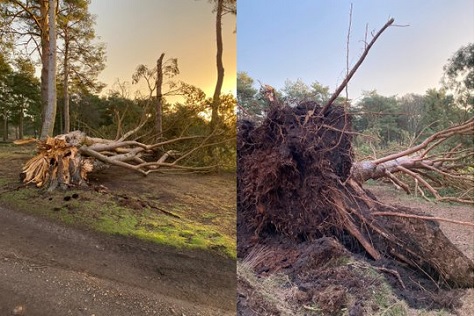
Storm damaged trees at Enville GC
It was inevitable that a storm of this magnitude would have such consequences, with damage seen to trees, structures and equipment.
With start of the cricket season less than eight weeks away, many cricket groundsmen will be counting the cost of this event in terms of lost time and damage to property. Many sight screens have been damaged and some grounds will have been saturated to a point that no planned pre-season rolling, or other work can be started until the grounds dry out.
However, I believe the best advice is not to panic, be patient and wait until ground conditions become favourable to undertake this pre-season programme of works. It is surprising how quickly the weather can change, at this time of the year.
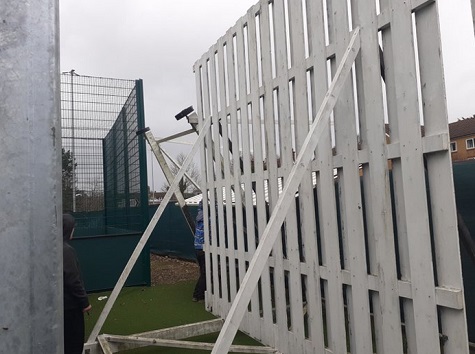
Storm damage at West Herts Sports Club
Come March we usually get a spell of warmer, dryer weather, which hopefully will improve ground conditions and allow the opportunity to complete pre-season works.
Rolling
Rolling plays an integral part in the process of cricket pitch preparation. It can improve the performance by compacting the soils, reducing live grass coverage and producing a smoother, uniformed surface.
Understanding what your rollers can and cannot achieve is very important. Knowledge of soil compaction, moisture content, soil swell and shrinkage, coupled with the importance of allowing pitches to dry, is all part of good pitch preparation.
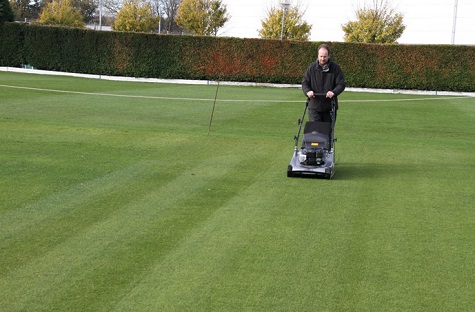
Pedestrian rotary mowing square
The aim of rolling a cricket square is to compact the pitch so that it is harder and more consistent. The harder the pitch, the less deformity will occur on ball impact, resulting in more pace and bounce. Rolling is part of good pitch preparation, not the most single source of producing great pitches.
There also needs to be optimum moisture content during rolling too. If the soil has dried out too much, the pitch will be too hard and strong and further compaction cannot take place. The same principles apply also if the soil is too wet.
Start your pre-season rolling with a light pedestrian roller (500kg); using the Union Jack system roll the square once from corner to corner, remembering always to return down the same line of roll. Turn off the square if you do not have a reverse gear to your machine.
Allow a couple of days for the square to breathe before repeating in the other direction. This should be enough to consolidate your table and reach rolling potential. This may take a couple of operations. Resist the temptation to continue rolling if severe creasing is in evidence (compressing of the surface). Conditions may be too wet! If you do not have an intermediate roller, e.g. 1000kg, then add some ballast to the light roller and roll across the square, we do not want to create a nap as this will affect the ball movement/swing during a match.
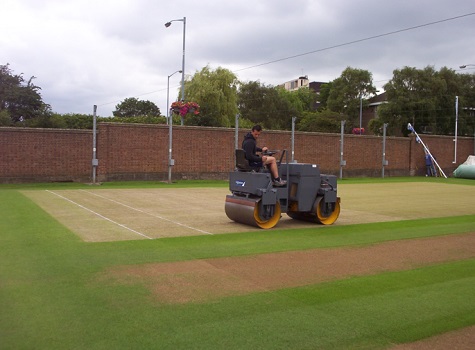
Pre -season rolling
Moving up to the heavy roller 1700kg to 2000kg, repeat the same principles as with the previous weighted rollers. Allow for drying time after each operation. This may be only one day as the square starts to dry out. By finishing your rolling in line of play this will assist in the pre-match day pitch preparation and help to ensure even compaction across the square has been achieved.
Other sports
As for football and rugby the improving soil and air temperatures will no doubt promote grass growth in the coming weeks and there will be a need to apply a dose of fertiliser to encourage this growth. There are so many good fertiliser products on the market now, the choice can sometimes be overwhelming. A simple soil nutrient test will help you decide on the NPK ratio you may require. Usually a spring / summer fertiliser produce with a lower rate of nitrogen will suffice. I personally like the 9:7:7 NPK ration type products or one with a dose of iron 6-5-10 +6Fe that will help control moss.
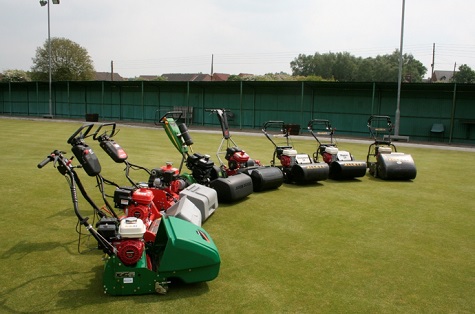
A selection of hand mowers
However, for me, the setting up and the upkeep of your mowing equipment are an integral and crucial part of your maintenance regime. There is nothing worse than having a mower that doesn’t start or cut properly.
Far too often it is this equipment that has been neglected and not maintained that leads to problems. Today’s mowers and compact tractors are an essential piece of equipment for most sports clubs and often the most expensive pieces of machinery to own.
By ensuring they are maintained and serviced regularly, by you local professional service dealer, they will serve your clubs well. I believe it is about times sports clubs valued the cost and investment required to maintain their facility and invest accordingly.